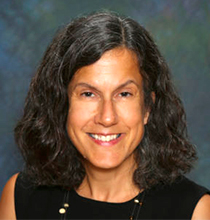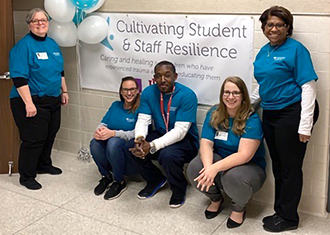Wanted: More Suicide-Prevention Education at Social Work Schools

Despite all the emphasis on mental health curricula at social work schools, one area that has received inadequate attention, some experts say, is how to prevent the worst-case scenario for a mental health client: dying from suicide.
“Most schools of social work think that this can be part of continuing ed after they graduate,” says associate professor A. Del Quest of Pacific University. “But it needs to happen before they graduate.”
Associate professor Jonathan B. Singer of Loyola University Chicago agrees, saying the learning gap comes down to lack of time and knowledge. “[In mental health] there is always more content to cover than there is time to cover it,” he says, adding that most faculty don’t have practice experience working with people who are suicidal and can be reluctant to teach the intimidating subject.
Background Helps
Singer, however, does have the experience, having launched his social work career as a social worker at a crisis center for children and adolescents. He later taught at the University of Texas at Austin, got a PhD to help him research family-based interventions and co-wrote “Suicide in Schools.”
In Loyola’s MSW program, hours-long modules on suicide ideation or prevention are included in various courses. One is Singer’s “Social Work Practice with Adolescents,” in which “students learn, among other things, how to talk to parents who have a teenager who’s suicidal,” he says. Also, about half of “Crisis Intervention” is devoted to suicide prevention and intervention, he adds.
Dedicated Courses Gain Traction
Pacific University has a new course completely dedicated to managing potentially suicidal clients and their families. It’s taught by Quest and was created based on a University of North Dakota clinical online course she has taught for years. But this one’s much more racial justice-focused, she says.
In “Suicide in Marginal Populations,” Quest shows how internal causes of suicide can be influenced by external factors like poverty, discrimination and lack of access to resources, to health care, to mental health care. She talks about grounding response and prevention to cultural factors such as language and traditional medical practices. “In teaching about practice with indigenous clients, for example, I’ll suggest they offer to help them access tribal traditional healers, if those practices fit for them.”
Quest also points students to researchers from specific racial or ethnic groups, such as professor Sean Joe of the Washington University’s Brown School for research on African American suicide.
Yet many social work administrators still believe there isn’t enough material to justify a full course on suicide. Not so, says associate professor Stacey Freedenthal of University of Denver, a former coordinator of its MSW mental health concentration who created and teaches “Suicide Assessment and Intervention.” The class is 30 hours, but “it still could go longer; there’s just so much to cover.”
The class first explores societal and students’ own beliefs and biases around suicide. Then it examines how to help clients get comfortable talking about the subject and whether they’ve had suicidal thoughts. Among other topics discussed are social justice implications; estimation and documentation of suicide risk; legal and ethical issues, like physician-assisted suicide; avoiding overreaction to client responses; evidence-based treatments; relapse prevention; and helping people who have lost someone to suicide. There are also role-playing exercises on such key practitioner responsibilities as risk assessment and safety planning.
Challenges to Come
The U.S. suicide rate, says the National Institute of Mental Health, increased 35.2 percent between 1999 and 2018, from 10.5 per 100,000 to 14.2 per 100,000. It decreased somewhat in 2019 and 2020, yet the long-term effects of the pandemic are unknown.
Such statistics may ultimately help draw more attention—and money—to social work education on suicide. Educators continue to look to large government and private entities to eventually fund major educational programs about suicide, such as the federal Substance Abuse and Mental Health Services Administration did with SBIRT (Screening, Brief Intervention, and Referral to Treatment) for drug use study and the John A. Hartford Foundation did for gerontology.
Meanwhile, Singer, who is in the middle of a three-year stint as president of the American Association of Suicidology, hopes to build a CSWE-accredited model online course on suicide ideation and prevention there that social work schools would allow interested students to take. “Then schools wouldn’t have to create the content,” says Singer. “They’d just have to say, ‘Yes, you will get credit for this course.’”
Any additional education would help, says Freedenthal, “because whatever environment you’re in in social work direct practice, you’re going to encounter people who have suicidal thoughts.”
Clarke University: Zeroing in on Integrated Health Practice

Dr. Colleen A. Mahoney, chair and associate professor of social work, talks about Clarke’s MSW program and its focus on integrated health social work education.
Your MSW program focuses exclusively on integrated health social work practice. Why so specialized?
When the MSW program started in 2014, we knew we were going to be small and it would be difficult to offer multiple concentrations, so we decided on mental health and physical health. Then in teaching the material we were dissatisfied with how the two were stuck in their own silos, so to speak, and felt there was redundancy. So, knowing how mental health and physical health actually work together, we began looking to make the curriculum more integrated.
How does this concentration most benefit students and, ultimately, their clients?
Not only do students learn the importance of knowing about someone’s physical health problems when performing mental health services—and vice versa—but part of our integrated health education is helping students recognize that health, broadly speaking, can be affected by many socio-cultural factors. It’s about understanding, for example, the role of social determinants in affecting such things as access to health services, as well as racial and ethnic disparities in health outcomes.
How does your MSW prepare students who may go into a non-health sector of the profession?
There’s lots of crossover in our courses. For instance, we have a course called “Social Work in School Settings.” It doesn’t meet requirements for some state licensure or certification as a “school social worker,” but it certainly provides enough information and background about how schools work—and how professionals outside of teaching might contribute to the well-being of kids. We’ve had graduates who have become behavioral health or resource development experts in schools, for example, with titles like mental health specialist or outreach coordinator.
Indiana University: Community-Engaged Research 2.0

Pictured: Associate professor Barbara Pierce (left) with researchers and local school personnel at the kickoff of Responsive Schools Intervention, a community-engaged project to help school employees affected by trauma.
The 27-year-old social work PhD program at Indiana University has been going through some revision and strategic planning to be even more student-centered and research-based, and now community-engaged — with special emphasis on the latter — says professor Margaret E. Adamek, PhD program director.
Community engagement is actually a campus-wide research approach, says social work associate professor Barbara Pierce, Robert Wood Johnson Clinical Scholar Fellow. It’s basically about taking research out of its usual bubble and drawing more on community resources. It has included such projects as biology students working with city officials on safe water research.
From a group of community-engaged researchers she’s part of, Pierce, who’s leading the social work PhD program rethink, got the idea of developing a course to show students how “to invite community members to be part of a research team to help solve problems.”
Enter “Community-Engaged Participatory Research: Approaches to Implementation and Evaluation.” One PhD student who took the new course is Jennifer Hippie, MSW, LCSW, a clinical assistant professor of field instruction at the university. One of Hippie’s field placements got her interested in police social work (good timing!). Now she’s doing her PhD research internship with — in partnership with assistant professor Isabel Logan at Eastern Connecticut State University with — on “the influence of social work education and practice in law enforcement agencies and the impacts social workers can have at the micro, mezzo and macro levels.”